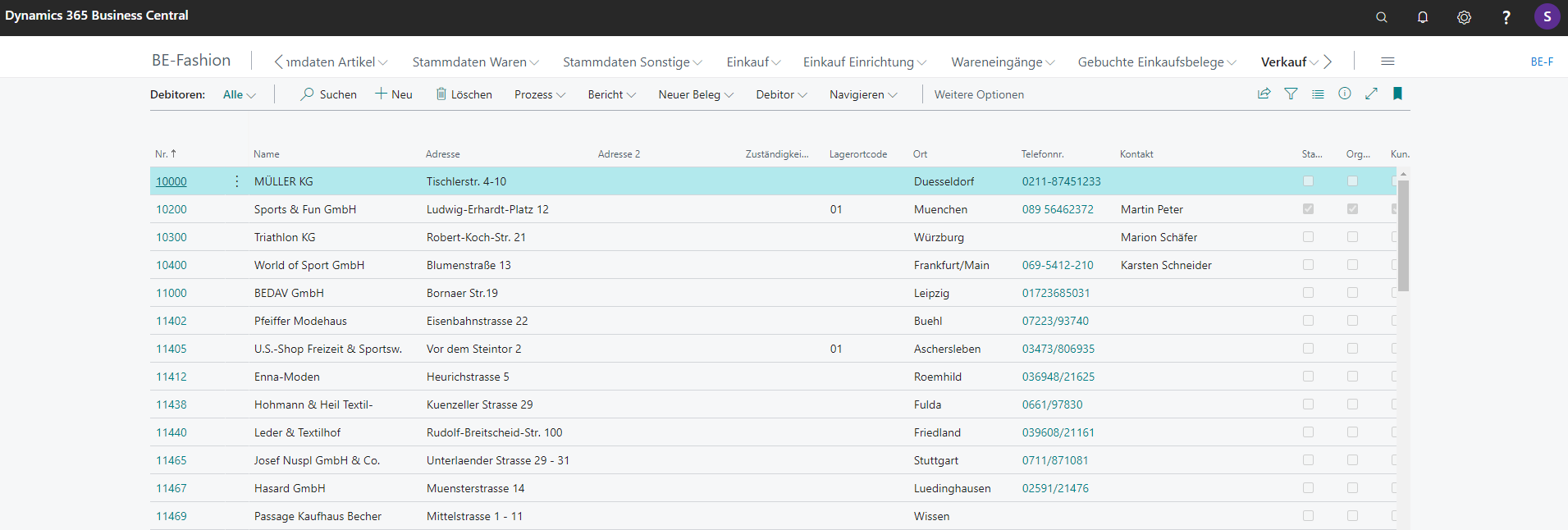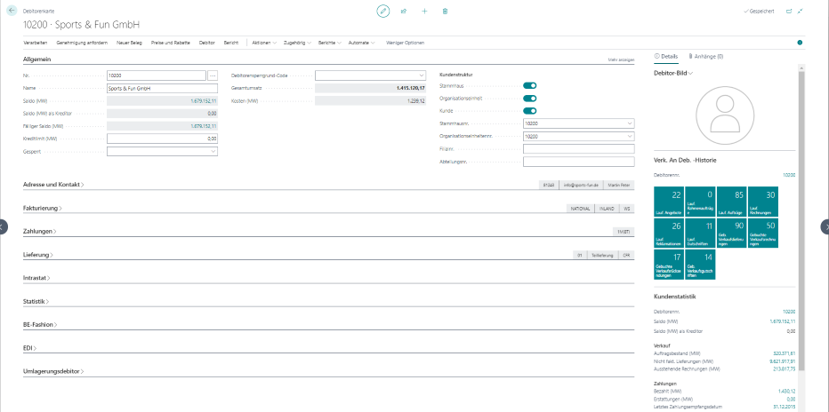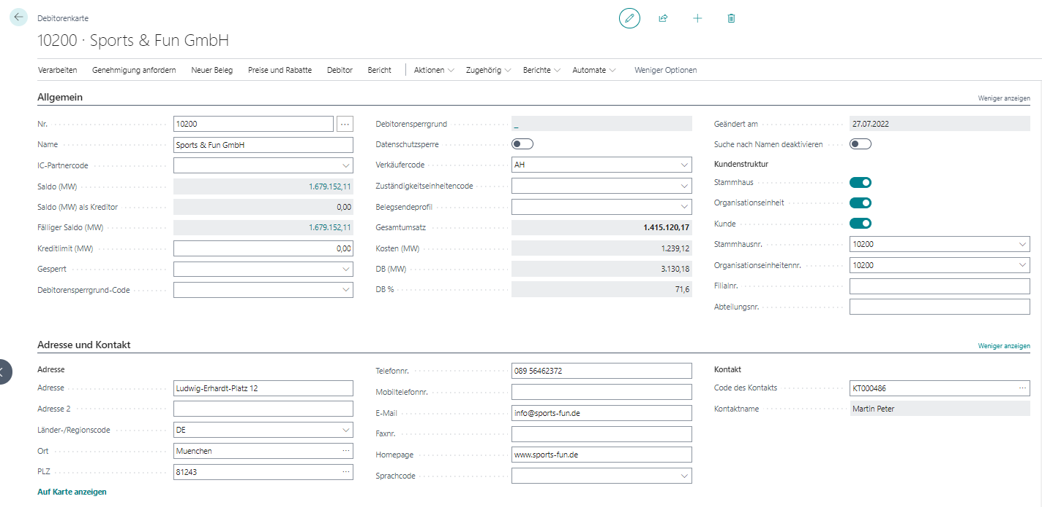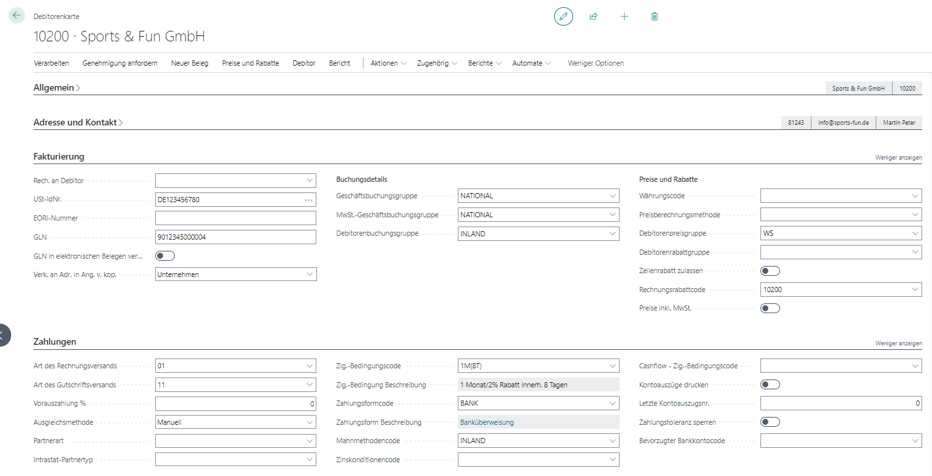Here you can see all registered customers, their balances and sales statistics. With customer templates, you can quickly create new customers with common details defined by the template.
Accounts receivable correspond to accounting entities that are used for sales and receivables management. Debtors therefore essentially correspond to the customer base. Depending on the business orientation, debtors are structured. The structuring ranges from simple structures such as simple B2B/B2C customers to more complex store lists and department stores. The customer structure list can be used to display them. Data exchange via EDI is controlled by a linked EDI partner.

In accounts receivable, you can set up the following options:
| Field | Explanation |
|---|---|
| No. | Specifies the number of the involved item or record according to the specified number series. |
| Name | Specifies the customer name. This name appears on all sales documents for the customer. |
| Address | Specifies the address of the customer. |
| Jurisdiction unit code | Specifies the code of the ownership unit (for example, a logistics hub) associated with the participating user, tenant, vendor, or customer. |
| Storage location code | Specifies the default location from which sales to this customer are processed |
| Place | Specifies the location of the customer. |
| Telephone No. | Specifies the customer's phone number. |
| Contact | Specifies the name of the contact person with this customer. |
| Parent company | Specifies whether the customer is a parent company. |
| Organizational unit | Specifies that the customer is an organizational unit. |
| Customer | Specifies whether the record is a customer. |
| Ancestral house no. | Specifies the ancestral house number. |
| Organizational unit no. | Specifies the organizational unit number. |
| Branch No. | Specifies the branch number. |
| Department No. | Specifies the department number. |
| Accounts receivable group | Specifies a customer group. |
| Accounts receivable group description | Specifies a description for the customer group. |
| VAT ID No. | Specifies the customer's VAT identification number. |
| Seller Name | Specifies the name of the seller. |
| Code Cost Center | Specifies a cost center code. |
| Prices incl. VAT | Indicates whether admission prices include VAT. |
| Rech. an Deb.-Nr. | Specifies the number of the customer to whom you are sending the invoice |
| Standard Fitness | Specifies the default condition. |
| Standard delivery address | Specifies the default address. |
| Payment form code | Specifies the payment form code. |
| Payment Form Description | Specifies a description for the form of payment. |
| Stock Transfer Customer Location Code | Specifies the location code of the transfer order. |
| Stock Transfer Customer Location Description | Specifies the location description of the transfer order. |
| Type of invoice dispatch | Specifies how the invoice is output. |
| Type of credit note dispatch | Specifies how the credit is spent. |
| Delivery person name | Specifies the name of the delivery person. |
| Delivery Term Code | Specifies the delivery term code. |
| Delivery Term Description | Specifies the description of the delivery term. |
| Balance (MW) | Specifies the payment amount that the customer owes for completed sales. This value is also known as the customer's balance. |
| Fälliger Saldo (MW) | Specifies the payment amount that the customer owes for completed sales. This value is also known as the customer's balance. |
| Sales (MW) | Specifies the total net amount of sales to the customer in MW. |
| Paid (MW) | Specifies the total amount of payments received from the customer. |

The customer card contains all data about the customer. The data entered in the registers is displayed via fast tabs. In each tab, additional fields can be displayed via 'Show more'.
https://learn.microsoft.com/de-de/dynamics365/business-central/sales-how-register-new-customers

| Field | Explanation |
|---|---|
| No. | Specifies the number of the involved item or record according to the specified number series. |
| Name | Specifies the customer name. This name appears on all sales documents for the customer. |
| IC-Partnercode | Selection of the intercompany partner if the customer is used for intercompany processes. |
| Balance (MW) | Specifies the payment amount that the customer owes for completed sales. |
| Balance (MW) als Creditors | Specifies the amount that you owe this vendor. This is relevant if the vendor is also the customer. The amount is the result of netting their liabilities and receivables. |
| Fälliger Balance (FW) | Specifies payments from the customer that are overdue after today's date. |
| Creditlimit (MW) | Specifies payments from the customer that are overdue after today's date. |
| Locked | Choose from: Delivery, Invoice or All. Specifies transactions where the customer cannot be processed, for example, because the customer is insolvent. |
| Customer Lock Reason Code | Specifies what the customer is blocked for. |
| Accounts receivable blocking reason | Specifies the description of the selected block reason code. |
| Privacy block | Specifies whether to restrict access to data of the data subject in daily operations. This is recommended, for example, to protect data from changes when it is checked under data protection law. |
| Seller Code | Specifies a code for the seller that typically handles this customer's account. |
| Jurisdiction unit code | Specifies the code for the unit of responsibility that manages this customer by default. |
| Document Sending Profile | Specifies the preferred method for sending documents to this customer, so you don't have to select a send option every time you post a document and send it to the customer. Sales documents to this customer are sent using the specified sending profile and override the default document sending profile. |
| Total turnover | Specifies the total sales revenue with the customer in the current fiscal year. It is calculated from the amounts excluding VAT for all closed and open invoices and credit notes. |
| Cost (MW) | Specifies how many costs you have incurred from the customer in the current fiscal year. |
| DB (MW) | Specifies how much contribution margin you have achieved from the customer in the current fiscal year. |
| dB % | Indicates how much profit you have made from the customer in the current fiscal year, expressed as a percentage of the customer's total sales. |
| Modified on | Indicates when the customer card was last modified. |
| Disable search by name | |
| Parent company | Indicator indicates whether the customer is a parent company (for example, administration). |
| Organization | Indicator indicates whether the customer is an organization (for example, department). |
| Customer | Indicator indicates whether the customer is a customer (for example, a branch). |
| Ancestral house no. | Selection of the customer number of the parent company. |
| Organizational unit no. | Select the customer number of the organizational unit. |
| Branch No. | Registration of the branch number. |
| Department No. | Registration of the department number. |
MS Standard


